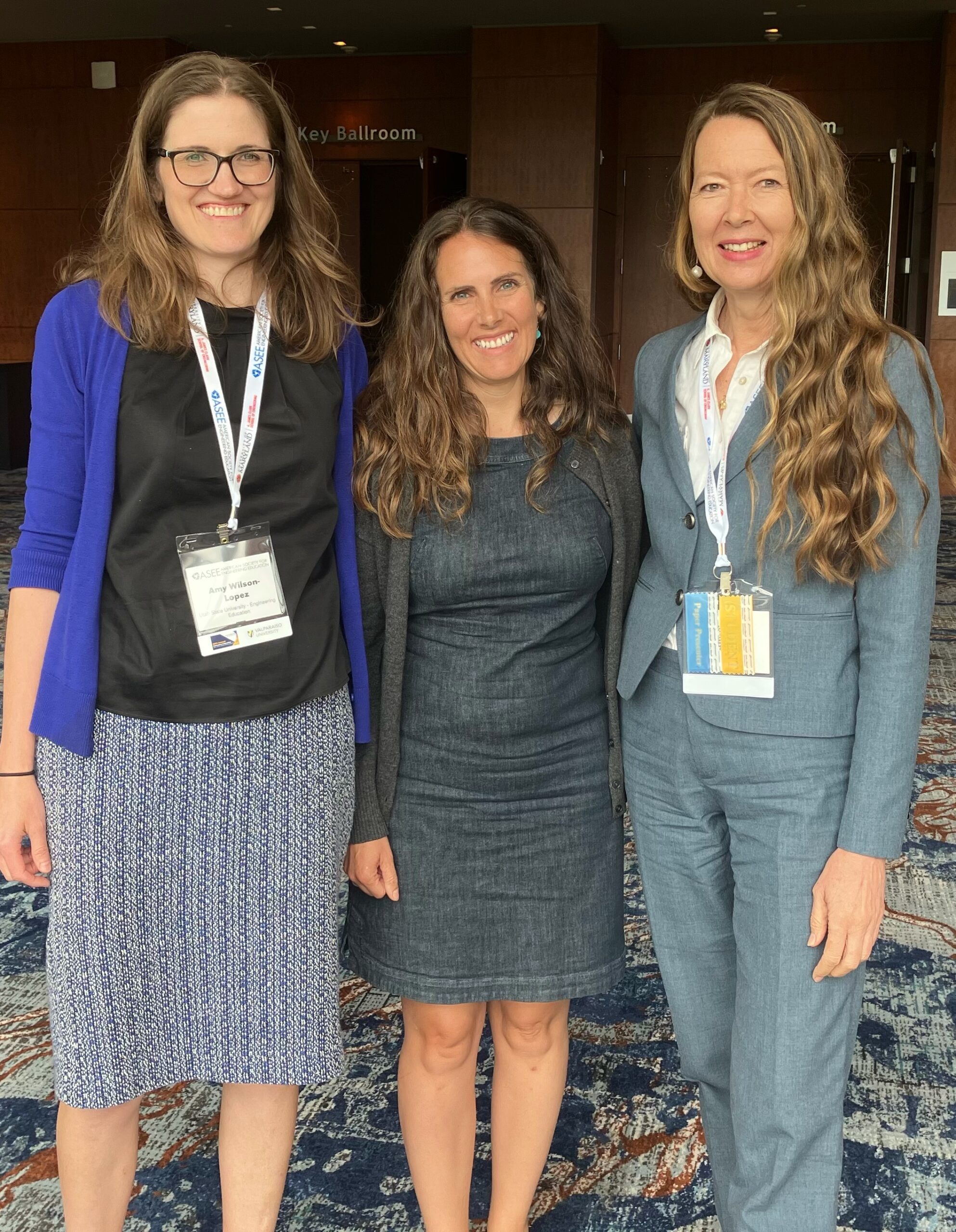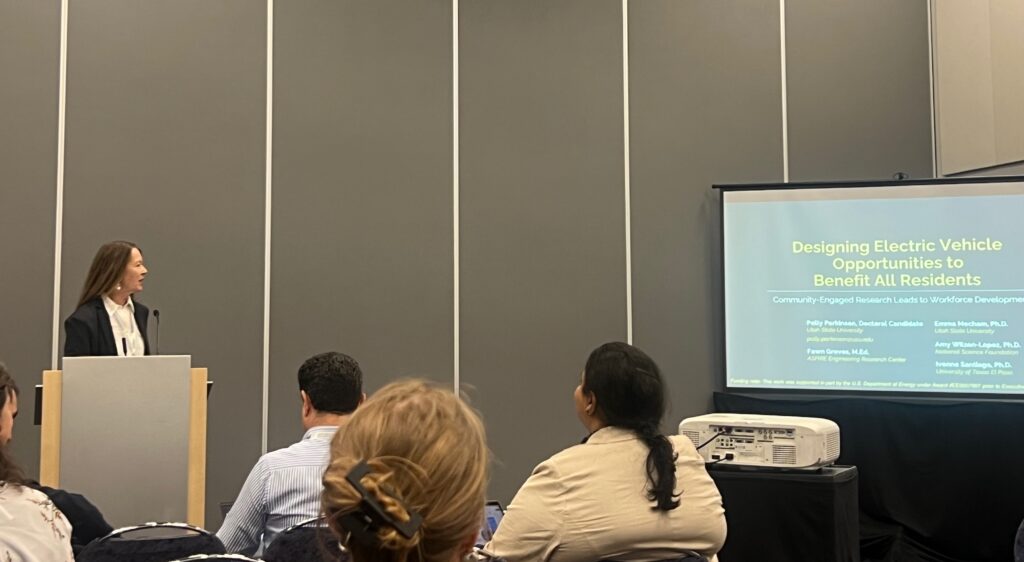Amplifying Community Voices: A Student’s Community-Engaged Research Approach

Imagine a world where researchers engage directly with the community — where the community’s voice and insights are not only heard but implemented. This open communication is then shared with professionals and academia across multiple disciplines, ensuring a collaborative approach to improving the quality of life for that community. This community-focused approach is the reality of ASPIRE Ph.D. candidate Polly Parkinson’s research methods for her study about EV adoption.
“Elevating community knowledge and addressing concerns were central to the study,” said the Utah State University student.
ASPIRE community engagement lead Fawn Groves, who worked with Polly to collect data from the community through participatory research, agreed.
“It was a community-centered framework where you go in with what you know and ways you can help,” Groves said. “But it’s very much a two-way learning process. We’re there to learn from community expertise and really tailor our research as we go to ensure that we’re benefiting the community.”
Their research, part of ASPIRE’s Project 4: Pathways, was the implementation of a plan by Amy Wilson, who is currently employed at the National Science Foundation. With the help of Groves and her mentor professor, Emma Mecham, Parkinson conducted four public survey sessions and 20 individual interviews, attended dozens of public meetings and events, analyzed the data, and wrote a paper, which was recently published in a peer-reviewed journal. (The paper is available to read here.)
“Our research resulted in a novel template for electric vehicle charging stations and concluded that EV adoption can advance mobility with a range of options that purposefully benefit the whole community,” Parkinson said.
From their research, they discovered cost is the most often cited barrier to EV adoption, with charging/infrastructure issues the next most cited concerns. In addition to these concerns, they recognized that the community is interested in possible jobs from electrification and the amenities available for all residents at EV charging stations.

In response to the community’s interest and concerns, the ASPIRE team created a career guide booklet, “a print and online resource of jobs related to electrification, including demand, pay rates, required training, and links to local education and apprenticeship programs,” Parkinson explained.
After sharing their findings and research with the community, they ensured the community’s voices were heard by experts in the field as well.
“After conducting the community-engaged research, our team felt a deep ethical obligation to advance the views shared with us, and to make the data part of professional and academic discussions,” Parkinson said. “Although interdisciplinary research has the huge benefit of sharing ideas and solutions across areas of expertise, I learned that it is not easy to unite the various experts.”
Parkinson’s mentor professor Emma Mecham agreed, highlighting this research study as a way to begin bridging that gap.
“Interdisciplinary work in engineering is rare and there are significant challenges to its successful design, implementation, and reporting,” Mecham said. “While the impacts of engineering innovation can be seen in daily life nearly anywhere you look, the field often fails to consider people and communities on the front end in humane, and contextualized ways. This research project responds to those gaps in meaningful ways.”
Despite the difficulty, Parkinson and her team at ASPIRE worked hard to publish their findings and ensure their research and the community’s voice was heard to ensure further benefits and improve their quality of life.
“Transportation planners, engineers, and community policymakers can act upon these findings to benefit the entire community, beyond the small percentage of EV drivers,” Parkinson stated.

This study has influenced not only other experts and community members but also taught her valuable skills.
“The experience has changed how I will live as an engaged citizen myself, and work as a community-engaged researcher,” Parkinson stated. “It has qualified me for jobs and fellowships that would not otherwise be options. I feel excited to be better equipped to possibly help find solutions to some of the issues that truly concern me.”
Her faculty mentor further emphasized Parkinson’s growth and diligence throughout the research process.
“Polly is a deeply conscientious scholar and human being. Her work was thoughtful, detailed, and self-reflective,” Mecham said “Polly continually sought opportunities to gain new skills and to receive critical feedback on her work to improve the work and her skill sets.”
Groves agreed, citing Parkinson’s “thoughtful and purposeful approach to research,” as a great asset to their research team.
ASPIRE is deeply committed to ensuring these research experiences benefit stakeholders, the field, and the individual student researchers to prepare them for their future career.
“The work of students like Polly is central to the contributions that ASPIRE has to offer to the fields they study in,” Mecham said. “As students are given substantive research opportunities and publishing credit for their work, they are positioned to carry forward the lessons of ASPIRE to new spaces and domains. “
For students interested in learning more about ASPIRE’s research efforts, reach out to Melanie Conrad.
About ASPIRE:
ASPIRE, a National Science Foundation Engineering Research Center headquartered at Utah State University, leads groundbreaking research and development to accelerate electrification. With over 400 global collaborators, ASPIRE focuses on creating seamless, affordable electrified transportation systems, accessible for all vehicle classes, along with the public infrastructure needed to support them. By reducing emissions, improving air quality, and fostering economic growth through job creation and workforce training, ASPIRE’s work spans engineering, social science, policy, and business. Partnering with top universities, industry leaders, and community groups, ASPIRE is driving the future of advanced transportation. Learn more at aspire.usu.edu.
Contacts:
Melanie Conrad
Student Engagement Coordinator
ASPIRE ERC
Writer:
Kayleigh Kearsley
Marketing & Communications Intern
ASPIRE ERC